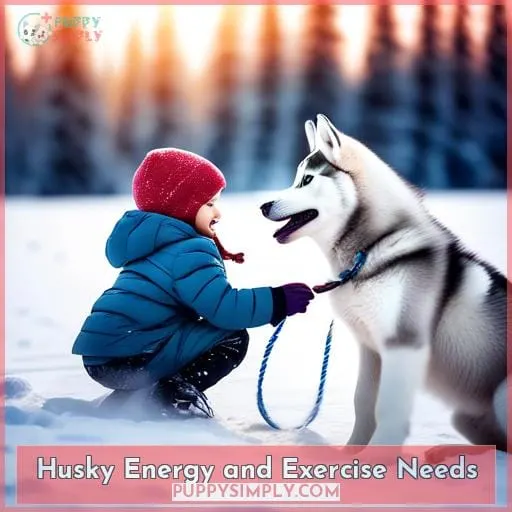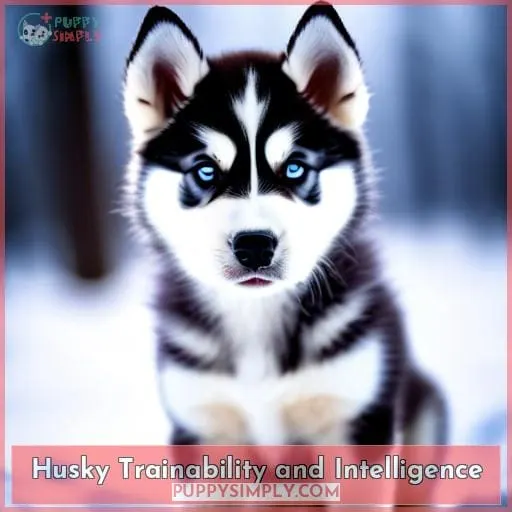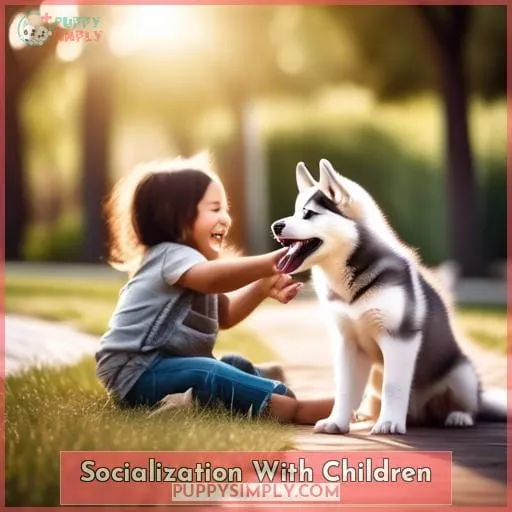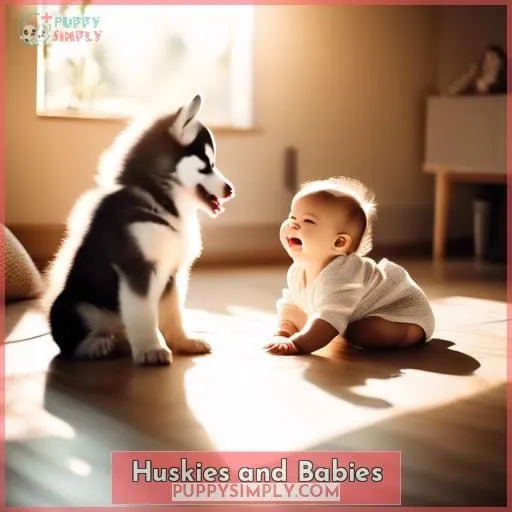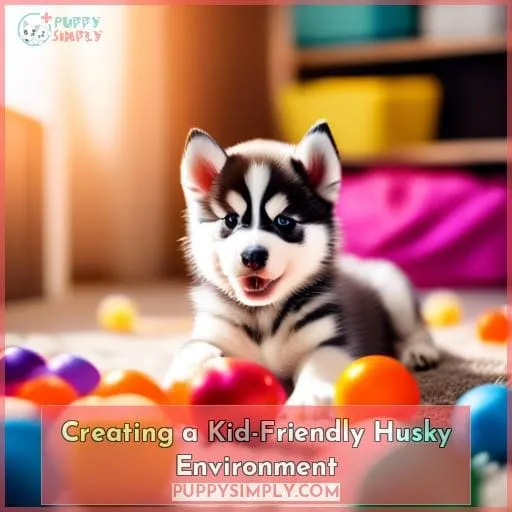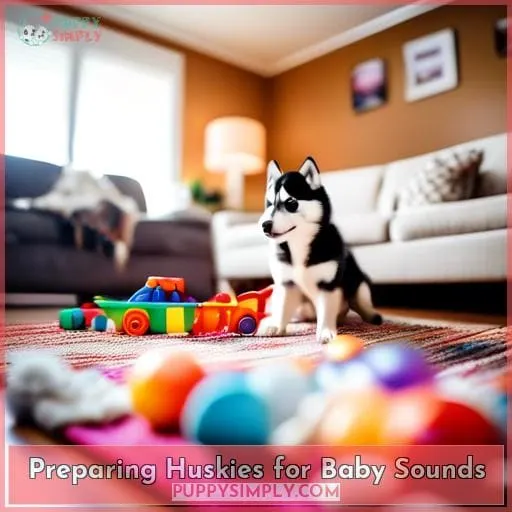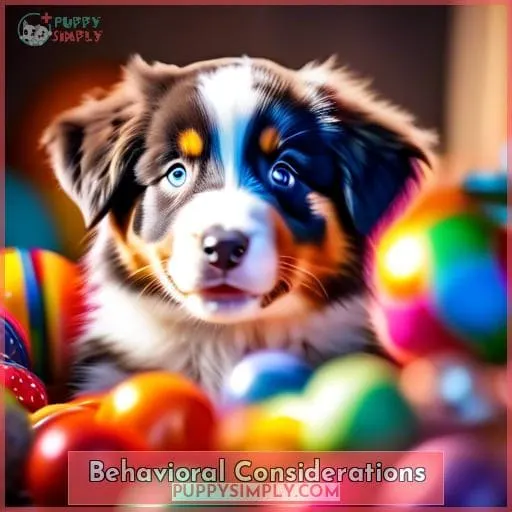This site is supported by our readers. We may earn a commission, at no cost to you, if you purchase through links.
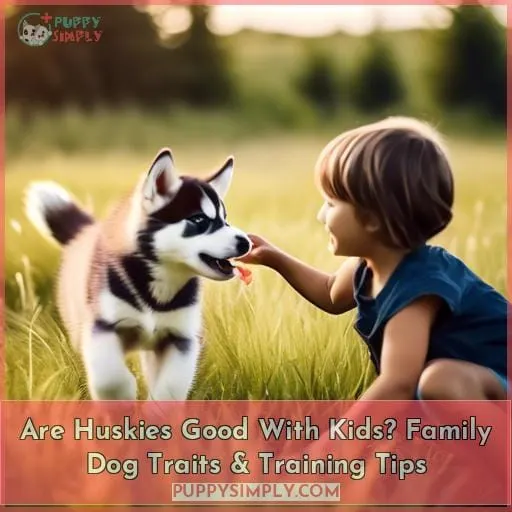 Imagine a fluffy, four-legged tornado with a heart of gold—that’s your husky puppy in a nutshell.
Imagine a fluffy, four-legged tornado with a heart of gold—that’s your husky puppy in a nutshell.
Now, throw in a couple of kids, and you’ve got a recipe for chaos, right? Wrong.
Huskies are not just good with kids; they’re fantastic family members, offering boundless energy and affection.
As a certified dog trainer, I’ll guide you through understanding their playful temperament and how to harness it, ensuring a harmonious household.
Let’s dive into the world of huskies and kids.
Table Of Contents
- Key Takeaways
- Husky Temperament Traits
- Husky Energy and Exercise Needs
- Husky Trainability and Intelligence
- Socialization With Children
- Huskies and Babies
- Creating a Kid-Friendly Husky Environment
- Preparing Huskies for Baby Sounds
- Walking Huskies With Strollers
- Behavioral Considerations
- Health Benefits of Dogs for Kids
- Frequently Asked Questions (FAQs)
- Conclusion
Key Takeaways
- Huskies have an affectionate, loyal nature and friendly demeanor that allows them to thrive in family settings with proper socialization
- Well-integrated huskies that understand household dynamics through clear hierarchy and training can become kid-friendly dogs
- Meeting a husky’s high exercise needs is crucial for managing their energy levels around children
- Early and proper exposure to children through supervised interactions helps huskies successfully coexist with kids when raised together
Husky Temperament Traits
Huskies are known for their affectionate and loyal nature.
They thrive in family settings where they can be part of the pack.
Their temperament makes them particularly suitable for homes with children.
They exhibit a friendly demeanor and a willingness to engage in play.
It’s important to remember that while huskies are generally good with kids, their high energy levels and need for exercise mean they require proper training and socialization.
This ensures harmonious interactions with younger family members.
Affectionate and Loyal Nature
Displaying an affectionate and loyal nature, huskies often become integral members of their human families.
Their temperament is generally friendly, and they form strong bonds through various bonding activities, making them family-friendly dogs.
However, handling their independence can be a training challenge due to their intelligence and sometimes stubborn nature.
Family integration is key, as huskies view their human families as their pack, providing emotional support and companionship.
It’s important to remember that each husky has its own personality, and their behavior with children can vary.
Therefore, careful husky training and socialization with children are essential for a harmonious household.
Pack Mentality and Family Dynamics
Huskies typically integrate into family life as they would with a pack, often seeking a clear hierarchy and role within the household dynamics.
This pack bonding is crucial for establishing a harmonious environment where everyone, including children, understands their place and responsibilities.
Canine hierarchy isn’t about dominance but about social integration and group dynamics, fostering family unity.
For a husky to thrive as a family pet, especially with kids, recognizing and nurturing these husky family dynamics is essential.
A well-integrated husky becomes a kid-friendly dog, enriching the family experience.
Husky Energy and Exercise Needs
Huskies are high-energy dogs that thrive on physical activity.
Their exercise needs are a crucial aspect of their care, especially in homes with children.
Ensuring they receive at least 2 hours of exercise daily can prevent destructive behavior stemming from pent-up energy.
This level of activity not only keeps them physically fit but also mentally stimulated, reducing the likelihood of anxiety and restlessness that could affect their interactions with kids.
Importance of Physical Activity
Bridging from their affectionate and loyal nature, you’ll find that meeting a Siberian Husky’s exercise needs is equally crucial for their well-being.
Outdoor adventures, indoor activities, and canine sports are all excellent ways to keep your husky active and engaged.
Outdoor adventures: Huskies thrive on long walks, hikes, and swims.
Indoor activities: Interactive play and mental stimulation are key, especially for husky puppies.
Canine sports: These provide both husky exercise and socialization, enhancing their suitability as a family pet when interacting with kids.
Potential for Destructive Behavior
A Husky’s energy needs, if not met, can lead to your dog’s destructive behavior.
Without adequate exercise, a Husky may channel pent-up energy into chewing, digging, or escaping.
To prevent such issues, prioritize daily physical activity.
Consider environmental enrichment and mental stimulation strategies to keep your Husky engaged.
Training reinforcement, such as positive reinforcement training, is essential in managing potential Husky aggression.
Exercise alternatives on bad weather days are crucial.
Husky Trainability and Intelligence
When considering a husky’s trainability and intelligence, it’s important to recognize their dual nature.
Huskies are intelligent and capable of learning quickly.
Yet, they can exhibit a stubborn streak that requires consistent and patient training efforts.
As you prepare to integrate a husky into a home with children, remember that obedience training is essential.
Managing their independent tendencies is a key part of the process.
Obedience Training Essentials
Moving from the high energy and exercise needs of Huskies, it’s crucial to harness that vigor through consistent obedience training, which taps into their intelligence and eagerness to learn.
You’ll find that with the right approach, your Husky can quickly pick up basic commands and even enjoy the learning process.
Investing time into positive reinforcement training is key for shaping good behavior in Huskies.
Be patient and consistent with training, as this builds communication and bonding.
Well-socialized Huskies that understand cues like sit and stay are better equipped to interact safely with children.
Managing Stubbornness
You’ll need to be patient when training these intelligent pups, as their stubborn streak can make huskies a challenge to handle at times.
Use positive reinforcement techniques, rewarding good behavior with treats and praise.
Establish a strong bond through walks, play, and grooming. Huskies thrive when they feel connected.
Understand the husky mindset. They were bred to run and pull sleds for miles. Meet their high activity needs to curb stubborn tendencies.
Consistency and understanding their nature is key when working with headstrong huskies. Patience paired with proper techniques enables positive, effective training for both husky and human.
Socialization With Children
You’ll want to properly socialize your husky puppy with children.
Supervise all interactions, especially with young kids, and teach children how to appropriately approach and handle the pup.
Getting your husky used to children early on through positive exposures can lead to successful coexistence when raised together.
Early Exposure Benefits
Introduce your husky puppy to children early on so it can become comfortable around kids during its critical socialization period.
Early exposure teaches puppies to be relaxed and confident around children, building a strong foundation for safe interactions.
Puppies that meet children of different ages and activity levels while young are less likely to find kids startling later on.
Socialization reduces anxiety and prevents negative conditioning that could lead to fear-based reactions.
Let children give treats, as positive reinforcement cements positive associations.
Supervise all interactions to prevent accidents and guide appropriate play.
Ultimately, early experiences largely shape how huskies perceive children throughout life, influencing the safety and success of this breed in family settings.
Supervision and Safety
You’ve taught the benefits of early exposure, now stress that all interactions require your watchful eye and readiness to intervene for safety.
When huskies play with children, continuously monitor their interactions.
Set clear boundaries for both the dog and child, teaching the child to respect the husky’s space.
Never leave them unsupervised.
During play, ensure the husky remains gentle and the child refrains from roughhousing.
If challenging behavior arises, immediately intervene to diffuse the situation and keep all parties safe.
Reactivity training may help curb concerning impulses.
Overall vigilance and proactive management allow positive socialization, preventing accidents while nurturing a lifelong bond.
Huskies and Babies
When introducing your husky puppy to a baby, set clear boundaries for gentle interaction.
Since huskies may mouth or nip during play, carefully monitor all interactions and redirect with an appropriate chew toy if needed.
Having chew toys on hand can curb mouthing behavior that could unintentionally harm a vulnerable baby.
Gentle Interaction Guidelines
How can you ensure calm yet affectionate engagement when introducing your husky to a newborn?
With supervision and proper social conditioning, huskies can interact gently.
Monitoring for mouthing is vital, as they may unintentionally injure babies.
Set clear boundaries and teach children to respect them.
For instance, designate a mat as the dog’s safe space.
Provide alternatives to mouthing, and reinforce gentle behavior.
Never leave a husky unsupervised around an infant.
Consult a qualified trainer or veterinary behaviorist to condition your husky to properly interact with babies in a calm, controlled way.
Husky puppies, babies, and kids need boundaries due to the husky breed’s playfulness.
Guidelines can help, but supervision is key when huskies interact with children to prevent injury.
Monitoring Mouthiness
As you monitor interactions, be mindful of your husky’s mouthiness.
Their playful behavior and teething tendencies could unintentionally injure a baby.
Teach bite inhibition through positive reinforcement training.
Redirect chewing to appropriate husky toys.
Use food puzzles and chew toys to occupy your husky.
Supervise all interactions between your husky and the baby.
I would advise monitoring your husky puppy closely when interacting with a baby.
Their natural mouthiness and tendency to chew could lead to accidental injuries.
Using positive reinforcement training, redirection techniques, and providing appropriate chew alternatives can help promote safe behaviors.
However, direct supervision is still essential to prevent potential harm to a vulnerable infant.
With patience and proper management, huskies can thrive in families with babies.
Creating a Kid-Friendly Husky Environment
You’ll want to set up safe spaces in your home where your husky can relax away from busy little hands.
Designate specific areas for your children and dog to play together and apart under supervision.
Providing each family member their own enriching areas can help create a calm, balanced environment.
Safe Spaces for Dogs
You’d do well to set up spaces where the child and husky can safely play apart from one another.
For example, consider:
- Crate training your Siberian husky puppy.
- Designating a dog run or outdoor kennel as the adult dog’s domain.
- Restricting bedroom access.
- Utilizing baby gates to establish kid-free zones within your home.
Enrolling in husky baby prep classes can provide guidance on introducing your existing husky to a new baby in a safe, positive manner.
With planning and training, both children and huskies can happily coexist within a thoughtfully designed family environment.
Designated Play Areas
Having established safe spaces within your home for your husky, you’d also do well to set up designated play areas for your kids and dog to interact safely.
Create indoor facilities like playpens and childproof rooms where your husky can’t access when needing downtime.
Outdoor spaces should have physical barriers securing your yard so your energetic husky stays safely contained.
Rotate access to toys and activities in these safe zones for separation benefits.
With proper preparation of playpen options and defined interactive areas, you can facilitate positive supervised playtime between your children and husky.
Preparing Huskies for Baby Sounds
You’ll want to play recordings of crying babies and other distressing sounds to get your husky accustomed to what they’ll be hearing once the real infant arrives.
As highly sensitive dogs, huskies can be easily startled by loud noises like a baby’s cries.
Start by playing quiet recordings of babies babbling or fussing, gradually increasing the volume over time.
This volume desensitization can help prevent a startle response when they hear the real thing.
Time the initial exposure to crying for when you can provide your husky an escape if needed – having a separate room or safe space reduces anxiety.
Pairing the sound with treats builds positive associations too.
With plenty of rewards and patience, you can condition your husky to comfortably cope with common baby noises.
Walking Huskies With Strollers
You’d do well accustoming your husky to walking calmly near a stroller by taking them on practice walks while someone else pushes it.
This allows you to focus fully on training without having to maneuver the stroller as well.
-
Start at a distance where your husky notices the stroller but remains relaxed.
Reward calm behavior with praise and treats.
-
Gradually decrease the space between your husky and the stroller over multiple sessions.
If your husky becomes reactive at any point, create more distance.
-
Work on having your husky sit or lie down near the stroller while it’s stationary.
Always set them up for success by keeping sessions positive.
Proximity desensitization can accustom huskies to strollers, allowing for safer family walks.
However, their high prey drive means leash manners require lifelong work.
Until excellent leash skills are achieved, using a basket muzzle provides an extra precaution to prevent grabbing at the stroller or bolting into traffic after squirrels.
Safety must remain the top priority.
Behavioral Considerations
If concerning behaviors emerge between your husky and children, seek help right away.
Reactivity and mouthiness may be managed through:
- Gradual exposure training
- Basket muzzle conditioning
Consult a credentialed trainer or veterinary behaviorist to ensure everyone’s safety and develop an appropriate plan.
Reactivity and Muzzle Training
If you’re dealing with a reactive husky, consider basket muzzle training regardless of their history.
This proactive step ensures safety for both kids and your furry friend.
Muzzle training, when done positively, can be a stress-free experience.
It’s not about punishment but about creating a secure environment.
A well-fitted muzzle allows your husky to breathe, drink, and even eat treats while preventing nipping during high-energy moments.
Always seek guidance from a professional to ensure a positive and humane approach to training.
Seeking Professional Advice
When it comes to any concerning behavior you notice from your husky around kids, you should consult a veterinarian or professional trainer for guidance on addressing it appropriately.
Managing shedding through regular grooming routines.
Considering dietary factors that influence temperament.
Bonding activities to establish trust.
The benefits of adopting rescued huskies with known histories.
Ongoing socialization for continued positive interactions.
As pack dogs bred for work, huskies require ample exercise and mental stimulation to prevent destructive tendencies. Establishing a kid-friendly environment entails providing your husky safe spaces for alone time along with designated play areas to expend energy.
Seeking professional advice ensures everyone’s safety while nurturing the special human-canine bond.
Health Benefits of Dogs for Kids
You’ve seen how huskies and kids can form special bonds through play, affection, and activities.
Interacting with a dog like a husky has additional benefits that support a child’s emotional and social development.
Growing up with a pet can teach children empathy, responsibility, coping skills, and important life lessons about relationships.
Emotional and Social Development
Your kids can develop empathy, compassion, and self-esteem from growing up with a pet husky.
As pack animals, huskies crave companionship, making them excellent family dogs that help children develop emotionally and socially.
Benefit: Emotional Intelligence
Explanation: Learning to understand the husky’s needs builds skills like empathy.
Benefit: Pet Responsibility
Explanation: Caring for a pet teaches accountability and commitment.
Benefit: Empathy Development
Explanation: Observing the dog’s emotions helps kids relate to others.
Benefit: Cognitive Skills
Explanation: Interacting with the clever husky builds cognitive abilities.
Benefit: Self-Esteem Boost
Explanation: Feeling trusted by an affectionate husky boosts confidence.
Studies show that the responsibilities and bonding from pet ownership lead to improved mental health for kids.
With appropriate supervision and training, a husky can be a wonderful companion that nurtures a child’s development.
Understanding Life Lessons
By watching a pet husky grow old or face health issues, you’re learning alongside your child about responsibility and impermanence.
1. Living with dogs can teach kids:
- Daily care routines
- Nurturing
- Sharing responsibilities
- Coping with loss
Up with huskies creates opportunities to understand life lessons and build character through sharing in the joys and responsibilities of pet ownership.
Frequently Asked Questions (FAQs)
Can husky puppies live in small apartments?
While husky puppies may enjoy companionship, small apartments are not ideal for their high energy needs.
Providing sufficient exercise and enrichment will be challenging in limited space.
Consider a medium to large home with access to a yard instead.
What health issues are common in huskies?
The most common health issues in huskies are:
- Hip dysplasia
- Eye problems like cataracts
- Hypothyroidism
- Autoimmune diseases
Providing proper nutrition, exercise, and routine veterinary care can help prevent or manage these conditions.
How much grooming and shedding can I expect from a husky?
Expect a husky to shed heavily year-round.
Weekly brushing can help control loose hair.
Bathing too often damages their undercoat, so limit baths to every few months.
Regular brushing and vacuuming are musts for husky owners.
Are huskies good with other pets like cats?
Unfortunately, huskies typically don’t fare well with feline friends.
Their high prey drive often overrides their companionship, resulting in stressful or dangerous interactions.
Careful supervision and training are essential for maintaining harmony.
What is the ideal diet for a husky puppy?
For growing husky puppies, an age-appropriate high-quality commercial diet is ideal.
This diet should be complete and balanced with all key nutrients.
Balance protein, fat, calcium, and calories for healthy growth.
Choose a large-breed puppy formula and feed the amounts recommended on the label.
Monitor growth and adjust as needed.
Conclusion
Though their boundless energy and independent nature can seem overwhelming, husky puppies’ affectionate and loyal temperament actually makes them fantastic family dogs when properly trained and socialized.
With early and consistent obedience training, exposure to children, and providing a stimulating outlet for exercise, are husky puppies good with kids?
The answer is a resounding yes.


